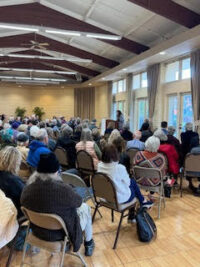By Larry Barnett
In his recent commentary in the Index Tribune, Fred Allebach continues to spin fables about the creation of housing in our community. Fables, as we all know, are filled with magical thinking, like poisoned apples, pied pipers, and secret spells. In Allebach’s Fables, housing is magically built by government wizards, private property rights poisoned, and economic differences erased by the wave of a wand.
Here in the real world where the rule of law exists, housing is built by developers and property owners, not government. Yes, government sets housing targets and zones property, but creating housing remains a market-driven process driven by desire for profit. Governments don’t build housing, developers do.
Back before 2012, local government used to have a steady source of money to contribute to housing creation. 20% of state redevelopment agency funding was mandated for affordable housing creation and the City of Sonoma helped finance many wonderful projects. The failure of the city to replace lost redevelopment funding was a terrible mistake, only recently addressed with new fees, assessments and regulations. It won’t be easy to make up for lost time, and meanwhile, the costs of real estate and construction continue to increase. Creating housing is all about money.
Allebach advocates that government mandate regional housing creation, a power government does not have except when it requires a percentage of approved new housing to be affordable, a requirement called inclusionary housing. Sonoma’s inclusionary requirement is 25%, the highest in Sonoma County. In general, government cannot force businesses or land owners to spend their money developing low-cost housing exclusively; government can only encourage such development by offering incentives such as land or money. Here in the real world, even when land is zoned for higher-density housing, its actual construction remains optional, not mandatory.
For all the virtue-signaling talk about affordability and equity, the newest state rules about housing that streamline application approvals and allow the subdivision of single family parcels impose no affordability requirements at all nor specify who it is that can move into new housing. That’s what happens when money-corrupted politicians funded by housing industry campaign donors vote in favor of new regulations written by housing industry lobbyists. When it comes to repeatedly creating boom and bust cycles, California’s housing industry is the unchallenged leader. And who buys up the foreclosed housing after each bust? Corporate America, that’s who; in the real world, nearly 50% of residential housing is now owned by housing corporations who rent them out, not resident owners.
In Allebach’s Fables, the rules of capitalism and the market economy do not exist; housing is developed by a wave of government’s wand. Government is not a wizard with a magic wand, however; it does not cast spells to make things happen, it sets rules for housing developers who want to invest their money in hopes of making a profit down the line. Those rules include zoning regulations that specify what types of housing can be built where; the rest is up to the developers, including the construction, sale, or rental price.
Wealth distribution is a complex matter of history, inheritance, free enterprise, cultural bias, bigotry, luck, talent and ambition. Fairness, unfortunately, has had little to do with it. Legislating morality and fairness is complicated and notoriously difficult, but in Allebach’s Fables economic and social equity are imposed on society through centralized planning dictated from above. It’s not the way the world works in America, at least not yet. Past attempts to create completely fair and moral Utopian societies, however well-intentioned, have either failed or devolved into authoritarian regimes.
The creation of affordable housing is a non-capitalist exercise. The developers who do that exercise best are non-profit housing corporations that specialize in building affordable housing. They leverage every penny they can muster for matching grants and funding, and unless local jurisdictions like the City or the County put money or land on the table, non-profit home builders build elsewhere. Those who want to see more affordable housing built in Sonoma should donate to the city’s Affordable Housing Trust Fund, so the city has more money to buy land or contribute to projects.
When it comes to housing, there is no magic wand to wave. The only thing to wave at it is money, and that’s no fable.
Larry Barnett was twice Mayor of Sonoma, served 12 years on the City Council and is the current Vice-Chair of Sonoma’s Planning Commission. He is also a member of the SUN’s Editorial Board.








Be First to Comment